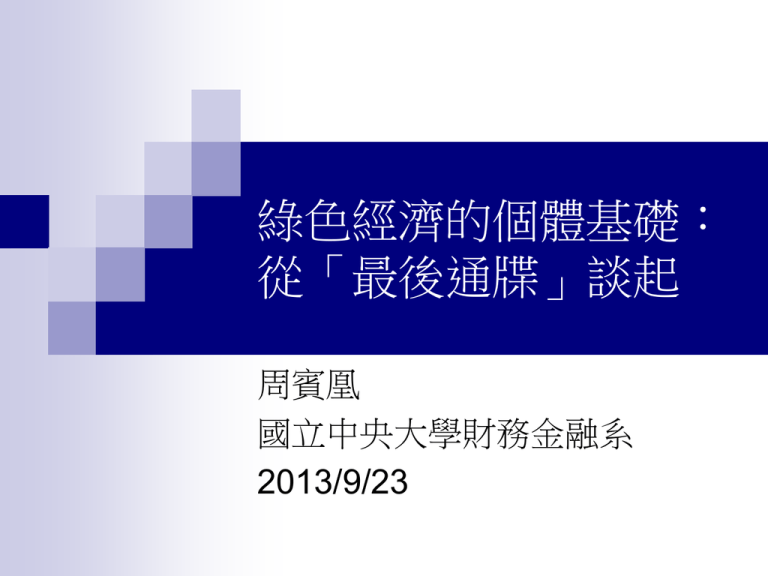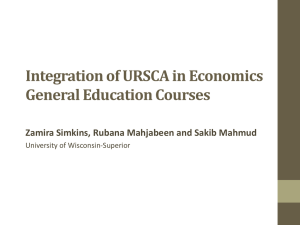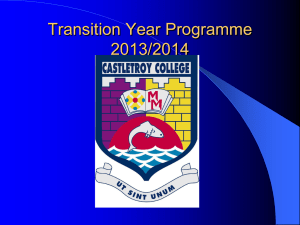綠色經濟學的個體基礎 I
advertisement

綠色經濟的個體基礎: 從「最後通牒」談起 周賓凰 國立中央大學財務金融系 2013/9/23 「最後通牒」遊戲 二人為一組(A為分配者,B為接受者)。規 則如下: 給A 1,000元:A選擇將c元分配給B。 B可選擇是否接受。若接受,則B得c元, 而A得(1,000-c)元;若不接受,則二人都得 0元。 你認為並預測合理的c為多少? 「最後通牒」遊戲 「理性」預測 1. 2. C趨近於零 B接受所有正的C值 Guth, Schmittberger, and Schwarze (1982), An experimental analysis of ultimatum bargaining, Journal of Economic Behavior & Organization Google scholar: 76,000 items; citations > 2,500. Results Two rounds, with a week break in between. Money: 4 or 10 DM First round (inexperienced) the modal offer was a 50 percent split (7 of 21 cases). The mean offer was 37%. Second round (more experienced) The mean offer was 32%, and only two players offered an even split. However, there was only one offer of less than DM1 and it was rejected. Also, three offers of DM1 were rejected as was an offer of DM3. 5 of the 21 offers were rejected. WHY DO PEOPLE DEVIATE FROM THE “RATIONAL” BEHAVIOR? Outline Alternative view 1: Neuroeconomics Critics of modern economics Alternative view 2: Green economics (or ecological economics) The story of ultimatum Origin and neuroeconomic evidence Why do we need “new” economics? Psychological foundation Green theory of “consumers” Green theory of the firm Conclusion Are economists different? Carter and Irons (1991), Are economists different, and if so, why? Ultimatum game Economists keep more, and accept less. It’s born, not trained. Frank, Gilovich and Regan (1993), Does studying economics inhibit cooperation? Economists behave in a more self-interested way. Exposure to self-interest model does encourage selfinterested behavior. => (implications for positive and normative economics) 森林裡的一棵樹 倒下,如果沒有 人在場,會發出 聲音嗎? Ultimatum Game in Neuroscience Alan G. Sanfey, James K. Rilling, Jessica A. Aronson, Leigh E. Nystrom, Jonathan D. Cohen, Science, 2003 The setting of the game: $10 for you and a stranger; stranger (human or computer) decides how to divide the $10. Most people reject if less than $3. Some reject if less than $5. 功能性磁核共振儀 大腦結構圖 左半腦解剖圖 腦是人體的控制中樞,它佔據著頭的上部空間,顱骨包圍著腦並有保 護作用。腦的主要部分稱為大腦,它被分成兩半,分別稱左、右大腦 半球。思考、學習、感覺以及發布指令的功能是覆蓋在每一腦半球的 一薄層灰質中完成的。內部的白質則負起連結腦的各個部分的作用。 左腦:serial computer; 右腦: parallel computer. 大腦結構圖 結構與功能 內容 大腦皮質 (Cerebral cortex) 思考 自主性運動 語言 推理 知覺 "cortex" 這個字在拉丁文中所代表的意思是 "樹皮", 這是因為大腦皮質 是由神經細胞所組成厚約僅2~6公釐的組織, 左右半球的皮質區是靠胼 胝體互相連接。 小腦 (Cerebellum) 運動 平衡 姿勢調整 "cerebellum" 這個字在中所代表的意思是 "小腦", 位於腦幹的後方。 小 腦和大腦皮質區一樣,也有所謂的半球結構。 腦幹 (Brain Stem) 呼吸 心跳 血壓 腦幹指的是位於丘腦與脊髓之間的區域,其中包含了medulla, pons, tectum, reticularformation及tegmentum等部份。 丘腦 (Thalamus),又稱視丘。 感覺 運動 丘腦負責接收來自感覺器官的訊號,並將之傳達至大腦皮質區。 丘腦下部 (Hypothalamus) 體溫 情緒 饑餓 口渴 心跳節奏 丘腦下部是人體內的溫度調節中心,可以感應體溫變化並適時給予調整。 又稱下視丘。 邊緣系統 (Limbic System) 情緒反應 邊緣系統包括了杏仁核(amygdala),海馬迴 (hippocampus),乳頭狀體 海馬迴 (Hippocampus) 學習 記憶 海馬迴屬於邊緣系統的一部份,在記憶和學習的腦部功能上扮演了極為 重要的角色。 基底神經結 (Basal ganglia) 運動 基底神經結實際上是globus pallidus, caudate nucleus, subthalamic nucleus, putamen和substantia nigra等區域的總稱, 在運動協調上有著重要的角色。 帕金森氏症的產生原因即是此區域發生病變所造成的。 中腦 (midbrain) 視覺 聽覺 眼球運動 身體運動 中腦包含了superior colliculi, inferior colliculi及red nucleus等區域。 (mammillary bodies) 以及扣帶迴 (cingulate gyrus)等區,此系統在情緒反 應的控制上非常重要。 大腦的四個腦葉 大腦被分成成左、右兩個半 球,兩個半球在構造上相似, 劃分為四個區域,稱為葉 (lobe)。 前方額頭附近的是額葉,主 要負責認知思考與決策。頭 頂的是頂葉,負責運動感覺 的體覺功能。在後腦勺的是 枕葉,負責視覺功能。兩側 靠近耳朵的是顳葉,主要是 聽覺功能。 四個腦葉主要功能 大腦四大區塊 枕 葉 顳額葉(顳葉) 功 能 視覺系統中的各個小區域碼上分辨、整合所收到的刺激。 聽覺,而且主管語言與長期記憶,尤其是語言的長期記憶。 頂 葉 前半部叫感覺運動區,主要工作是接收從身體各部位傳來的訊息,如皮膚的觸覺、肢 體的姿勢變化。後半部的頂葉,繼續分析、整合傳送進來的訊息。 額 葉 腦內的行政、策劃、思考與決策中心,隨時隨地做著重要的決定。 Time line and results fMRI : Greater activation for unfair offers from human partners bilateral anterior insula (前腦島): a region that processes information from the nervous system about bodily statessuch as physical pain, hunger, the pain of social exclusion, disgusting odors and choking. Insula cortex is activated during the experience of negative emotions like pain and disgust. ($好少…生氣!) dorsolateral prefrontal cortex (DLPFC) 背外側前額葉皮質 linked to cognitive processes such as goal maintenance and executive control. ($...好啊!) Anterior cingulate cortex (ACC) 前扣帶皮質 an “executive function” area which often received inputs from many areas and resolves conflicts among them. (平衡…) 前扣帶(anterior cingulate) 介於額葉與邊緣系統之間,維持思想與感 情的微妙平衡 社群意識、直覺、同理心與慈悲心 人類與少數靈長類所獨有 Panel A: Anterior insula activation is inversely related to acceptance rates. Panel B: Anterior insula activation is exceptionally high for rejected offer. Limbic justice: The role of amygdala Rejection of unfair offer is associated with higher activity in right amygdala. Males show greater response than females. Ultimatum Game: Cross-culture evidence People have intrinsic preference for fairness, get angry when unfair So angry that we punish the other at a cost of ourselves People reject low offers because they don’t want to appear weak Human evolves in small community Build up a reputation for toughness Others treat you better the next time In Search of Homo Economicus (JEP 2001) A variant: the dictator game The ultimatum game only looks at the responder (recipient), not the proposer (allocator). Kahneman, Knetsch, and Thaler (1986) The recipient cannot reject the offer. Of the 161 subjects, 122 (76 percent) made even offer. Why do people tend to give fair offer? Two possibilities: Compassion Empathy: because we feel the same Source: Could be born or as a result of social interaction in evolution. Understanding others: Brain mechanism of empathy ToM: Theory of Mind Important implication for “common knowledge.” 7至12歲孩童看到別人受傷的影片,頭部與 痛相關的區域也會活化起來 患有精神病與Alexithymia(一種有困難將自 己的感情化為主觀的體驗或是言語的古典 型的心身症症狀;自閉症者通常有較高程 度的Alexithymia)症者,則沒有同樣的反應 Charitable giving: Pure altruism or “warm glow”? Harbaugh, Mayr, and Burghart, Science 2007. 不論是將錢留給自己、捐出(自願或強制(類似稅)),伏 隔核、尾狀核(caudate)與腦島都活化。 伏隔核、尾狀核:愉悅與報酬中心;腦島:與同理心、慈 悲之情緒有關 Implications Fairness is important to humans, but there is no “fair” in economics; the best we can say is “pareto efficiency.” In economics, cooperation is explained by self-interest motivations in an infinitely repeated game setting. Homo Economicus 何謂「理性」? “Rational” merely means “reasonable”, “understandable,” and “consistent.” 這可視為「廣義的理性」,而經濟學的 理性,則是狹義的。 See next. 新古典經濟學中的「理性」? 1. 經濟學假設的理性行為,偏好需服從三定理: 完整性(completeness):若有A與B二財貨,則必 然 2. 3. A優於B,或B優於A,或二者無差異 亦即,比較偏好之關係必須是完整的 遞移性(transitivity):若A優於B,且B優於C,則A 必優於C。 不滿足特性(nonsatiation):越多越好(亦即「單 調性(monotonicity)」 效用函數 經濟學家證明,在上述假設下,再加上連 續性假設,個體的偏好可以一數量的函數 代表之,即所謂的「效用函數」。 此效用函數未必唯一,但必定存在。 個體的行為係以極大化效用函數為標的。 在不確定性下,則可以極大化預期效用來 處理。 The structure of microeconomics Theory of the consumer Theory of the firm Theory of markets Question: Are there behavioral or psychological linkages between the three? Some critics Purely self-interest; there is no role for emotions, either of oneself or others. => behavioral economics. A common, salient feature of theories of consumer and firm: alienation (疏離) U(x), x: consumption of goods and services; q(l,k), l: labor (work), only a factor of inputs No behavioral foundation for theory of firm; firms are made up of humans, but a firm’s objective is assumed to be profit maximization, which comes from nowhere. Market-based: see next slide. 修馬克(E. F. Schumacher) 對「市場」的批評 「市場只體現社會的表層」……「未能深 入事物的內在,或者是藏於事物背後的自 然與社會真相」 「市場是個人主義與不負責任的機構化。」 總結前言,新古典經濟學可以 說是病態的經濟學! Comparison of economics and psychology, Andrew Lo (2003) Psychology Based on observation and experimentation. Field experiments are common. Empirical analysis leads to new theories. Multiple theories of behavior. Mutual consistency among theories is not crucial. Economics Based on theory and abstraction Field experiments are not common. Theories lead to empirical analysis. There are few theories of behavior. Mutual consistency is highly prized. Homo sapiens from psychological perspectives Four major school of thoughts: Behaviorism 行為學派 Psychoanalysis 精神分析學派 Humanistic psychology 人本心理學 Positive psychology 正向心理學 Freud’s three identities of personality The id 本我: the most primitive part of the personality, representing biological needs and desires. 「唯樂原則(pleasant principle)」; 本能需 求 The ego 自我:介於本我與 超我之間,遵循「現實(reality) 原則」,平衡二者。 The superego 超自我: the part that contains our ideals, norms and values; 「至善 原則(perfection principle)」 容格(Carl Jung, 1875-1961) 本我才是整體心靈的協調中心;自我只是個人意 識的中心 心靈的四個層次: 1. 2. 3. 個人意識 個人潛意識 客體心靈(objective psyche):即集體潛意識, 人類心靈普遍存在的結構(包括情結(complex) 與原型(archetype)) 4. 集體意識 個體化(Individuation) 「人在現實生活中努力去認識 與發展其與生俱來的潛能」 Jung: “我的一生是一個潛意識自我充分 發揮的故事。”(My life is a story of the self-realization of the unconscious.” (from Prologue in Memories, Dreams, Reflections) 人本主義 Life is what you make it! Abraham Maslow (1908-1970), founded in 1943 Hierarchy of Needs Theory Basic survival requirements to group acceptance From emotional needs to intellectual growth Self-actualization with complete realization and harmony with self and life (其實就是容格 的「個體化歷程」) 正向心理學(Positive psychology) Origin: Proposed by Martin Seligman, the father of the modern positive psychology movement, in 1998. Seligman chose it as the theme for his term as president of the American Psychological Association, though the term originates with Maslow, in his 1954 book Motivation and Personality. Psychologists since the 1950s have been increasingly focused on promoting mental health rather than merely treating illness. Broad theories: 3 parts Research into the Pleasant Life, or the "life of enjoyment.” Seligman says that this most transient element of happiness may be the least important, despite the attention it is given. The study of the Good Life, or the "life of engagement." These states are experienced when there is a positive match between a person's strength and the task they are doing, i.e. when they feel confident that they can accomplish the tasks they face. Inquiry into the Meaningful Life, or "life of affiliation", questions how individuals derive a positive sense of wellbeing, belonging, meaning, and purpose from being part of and contributing back to something larger and more permanent than themselves (e.g. nature, social groups, organizations, movements, traditions, belief systems). 邁向圓滿 Flourishing 從快樂到幸福 幸福五要素 正向情緒(positive emotion) 全心投入(engagement) 意義(meaning) 成就(accomplishment or achievement) 正向人際關係(positive relationship) In Pursuit of Happiness: Life Satisfaction (nef)











